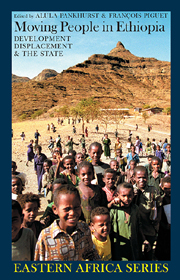Book contents
- Frontmatter
- Contents
- Acknowledgements
- Acronyms
- Glossary
- Notes on Contributors
- Preface: An Original Contribution to Country-wide Displacement Analysis
- Foreword by Alula Pankhurst & François Piguet
- Map
- Part I INTRODUCTION
- Part II THEORETICAL & INTERNATIONAL PERSPECTIVES
- Part III DEVELOPMENT-INDUCED DISPLACEMENT
- Part IV THE EXPERIENCE OF STATE-ORGANIZED RESETTLEMENT
- 9 Why Did Resettlement Fail?
- 10 Social Impact of Resettlement in the Beles Valley
- 11 Revisiting Resettlement under Two Regimes in Ethiopia
- Part V THE DILEMMAS OF REFUGEES, RETURNEES & DISPLACED GROUPS
- Part VI CONCLUSION
- Bibliography
- Index
- EASTERN AFRICAN STUDIES
10 - Social Impact of Resettlement in the Beles Valley
from Part IV - THE EXPERIENCE OF STATE-ORGANIZED RESETTLEMENT
Published online by Cambridge University Press: 05 April 2013
- Frontmatter
- Contents
- Acknowledgements
- Acronyms
- Glossary
- Notes on Contributors
- Preface: An Original Contribution to Country-wide Displacement Analysis
- Foreword by Alula Pankhurst & François Piguet
- Map
- Part I INTRODUCTION
- Part II THEORETICAL & INTERNATIONAL PERSPECTIVES
- Part III DEVELOPMENT-INDUCED DISPLACEMENT
- Part IV THE EXPERIENCE OF STATE-ORGANIZED RESETTLEMENT
- 9 Why Did Resettlement Fail?
- 10 Social Impact of Resettlement in the Beles Valley
- 11 Revisiting Resettlement under Two Regimes in Ethiopia
- Part V THE DILEMMAS OF REFUGEES, RETURNEES & DISPLACED GROUPS
- Part VI CONCLUSION
- Bibliography
- Index
- EASTERN AFRICAN STUDIES
Summary
Introduction
This chapter examines the social impact of the state-sponsored resettlement of the 1980s in the Beles Valley (Metekel), northwestern Ethiopia, imposed and driven by mixed motives to do with famine and drought prevention, food production, security and population control. The Beles Valley resettlement area is located along a tributary of the Abbay (Blue Nile) River, southwest of Lake Tana in the Metekel Zone of the Benishangul-Gumuz National Regional State. The area has a lowland altitude range of between 1000 and 1200 masl. The scheme is one of the biggest state-sponsored programmes of the 1980s and hosted people resettled from the drought-prone area of north-central Ethiopia and ‘over-populated’ areas from the southwest. The initially planned scheme was around 250,000 hectares (Salini Costruttori 1989: 8). The resettlers were relocated along the banks of the Beles River in 48 villages with an average number of 500 households each. At the peak of the process in 1987/88, the population reached a total of 82,106 (21,994 heads of household with 60,112 family members). The ethnic composition is very heterogeneous including: Amhara (from Wello, North Shewa, Gojjam and Gonder), Kambata, Hadiyya, Oromo (from South Wello and North Shewa), Wolayta, Tigraway, and Agaw (from Wello and Tigray), with a mixture of cultures from many parts of the country.
- Type
- Chapter
- Information
- Moving People in EthiopiaDevelopment, Displacement and the State, pp. 130 - 137Publisher: Boydell & BrewerPrint publication year: 2009

